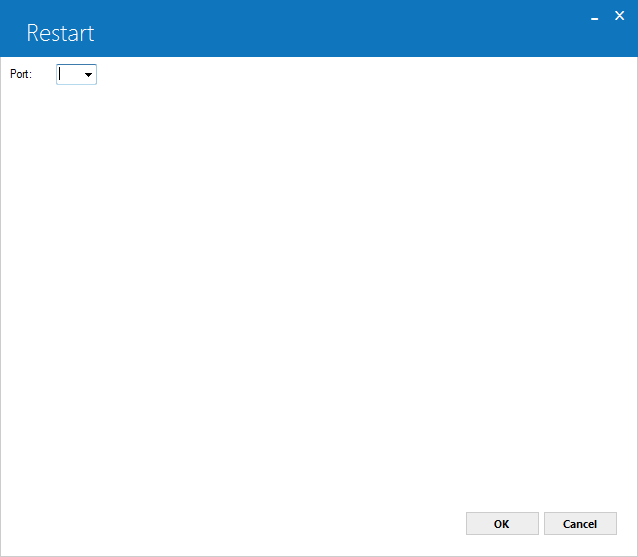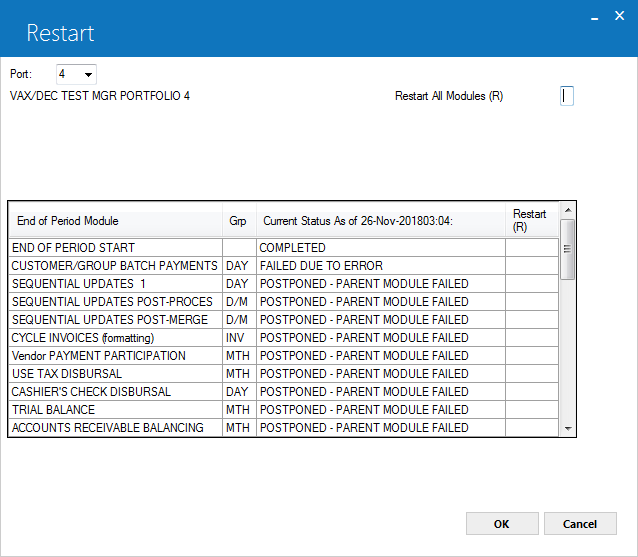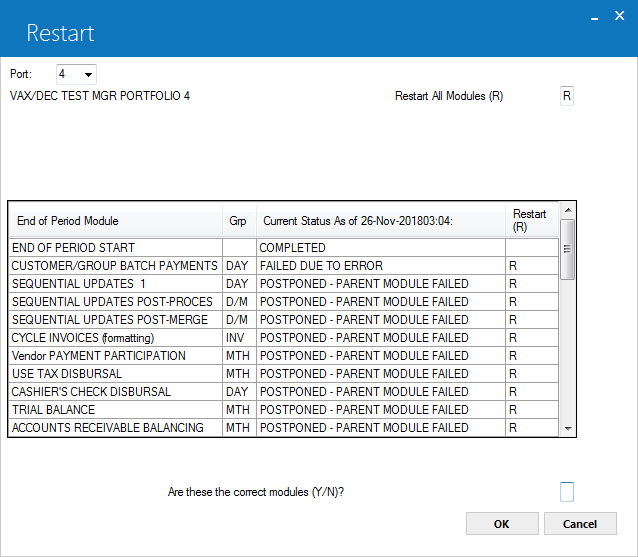 U04 End of Period
U04 End of Period
U0405 Restart
 Interactive: This is one of the interactive processess used to control and monitor End of Period. It does not have a batch counterpart or run as an EOP module.
Interactive: This is one of the interactive processess used to control and monitor End of Period. It does not have a batch counterpart or run as an EOP module.
 For more information about End of Period, refer to U04 End of Period Overview.
For more information about End of Period, refer to U04 End of Period Overview.
U0405 Restart resubmits one or more stopped modules to the End of Period batch queue. A stopped module may have been stopped intentionally by a supervisor or may have failed due to some program error or external circumstance (for example, a power failure).
U0405 Restart is a subset of U0404 Halt/Restart/Skip. U0405 Restart is designed for operators who may need to restart End of Period, but who are not responsible for determining whether modules may be halted or skipped. In general, security for users should be set so that neither U0404 or U0405 is allowed, or only one is allowed, but not both.
For example, if there is a power failure while End of Period was executing, the End of Period process must be restarted after power is restored. This may be performed by any user with the security to enter U0405 Restart, and does not require the additional authority for the U0404 Halt/Restart/Skip. However, if a module of End of Period failed due to another type of error, a supervisor or someone familiar with LeasePak and its processes would be needed to restart End of Period with U0404 Halt/Restart/Skip. This person must determine whether the module should be restarted or skipped and recovered.

This screen is used to enter the portfolio of the module to be restarted.

This screen is used to specify the End of Period modules to be restarted for the portfolio selected. The name of the portfolio is displayed and should be verified as correct before making any changes.
Field Descriptions
- RESTART
ALL MODULES (R)
Enter R to restart all stopped modules. Leave blank if specific modules should be restarted.
This field may be used to quickly restart all applicable modules. Once R is entered, the user may tab to individual modules and clear the R for those modules which should not be restarted. For example, if all modules are to be restarted except for one, enter R in this field. Press TAB and an 'R' appears next to all applicable modules in the module list. Tab to the one module not to be restarted and change the defaulted R to a blank.
A restarted module recovers the data files modified by the previous, unsuccessful execution of the module, and starts the module from the beginning. Only modules with the following statuses may be restarted:
FAILED DUE TO ERROR
HALTED BY SUPERVISOR
POSTPONED - PARENT MODULE FAILED
POSTPONED - PARENT
MODULE HALTED
A restart of all modules restarts all necessary End of Period modules to complete End of Period. This is often an easy and safe way to restart End of Period. However, failed modules may require a correction of some type before they can successfully finish.
- RESTART
(R)
Enter R to restart a stopped module. Leave blank if the module should not be restarted. If R is entered for the RESTART ALL MODULES field, all applicable modules are defaulted with R. These defaults may be changed for specific modules by moving to the desired module and clearing the defaulted R.

This screen is used to verify that the list of modules to be restarted, as entered on the previous screen, is correct.
Field Descriptions
- ARE
THESE THE CORRECT MODULES (Y/N)?
Enter Y to restart the selected modules. If Y is entered, when ENTER is pressed, the message "Batch job submitted" is displayed once for each module resubmitted to the batch queue (The message may appear to be flashing on the screen as it is redisplayed several times.)


